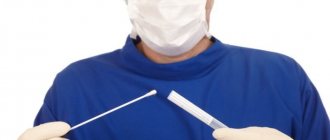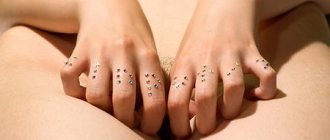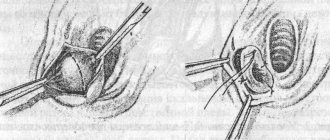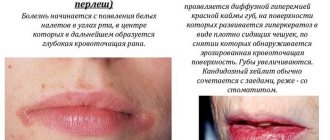Fatty deposits on the labia can form in women of any age and with any skin type. More often, those with oily skin encounter lipomas on the genitals, but this is not the only reason why a benign formation occurs in the intimate area. In the early stages and in the absence of infection, apart from the wen itself under the skin, which is clearly visible due to its clear outline and mobility, there may be no other symptoms. If for some reason the skin of the labia covering the wen was injured, pain and burning occurred, and the lipoma began to grow sharply, you should immediately contact a gynecologist.
Causes and types of lipomas
When examined by a gynecologist, it will be found out why wen appears on the labia. A specialist will help differentiate these lipomas from other benign formations. Sometimes women mistake certain deformations of the skin at the entrance to the vagina for a wen in the genital area.
Normally, the labia minora should be covered by the labia majora to protect the entrance to the vagina. Most often, deformation or asymmetry of the labia is congenital or occurs after childbirth or as a result of injury. This problem has nothing to do with wen and is eliminated in the clinic through the intervention of a plastic surgeon.
When differentiating a wen, it should be taken into account that a formation on the labia may appear due to inflammation of the Bartholin glands located at the entrance to the vagina. When they become infected, one or both labia become swollen and painful.
After a few days, a dense knot forms on the labia, which is also often confused with a wen. The lump can fester and, if not treated in time, forms a cyst. This process is often accompanied by a strong increase in body temperature.
A true wen, or lipoma, on the labia grows slowly and can maintain its size for a long period. Symptoms such as pain in the area where it is located, a burning sensation, can occur due to the fact that the wen has burst or is mechanically injured, for example, due to wearing too tight underwear.
Most often, the following types of formations occur in the intimate area:
- True lipoma is a benign formation consisting of adipose tissue located in the subcutaneous tissue of the pubis or labia majora. White wen can be no larger than a pea, but with complications they grow to large sizes.
- Fibrolipoma - this type of tumor is said to exist if, in addition to adipose tissue, it contains connective tissue.
- Fibroma is formed from the connective tissue of the labia majora.
- Myolipoma is formed in adipose tissue with admixtures of muscle tissue.
- Myoma grows in the thickness of the muscles of the labia majora.
- Hydradenoma - looks like one or many dense nodules in the thickness of the labia majora, is formed from the sweat gland when it is damaged.
In the intimate area, the following are less likely to form:
- myxoma - consists of connective germ tissue, localized under the skin of the pubis or in the thickness of the labia majora;
- papilloma - consists of the integumentary epithelium and occurs in the vestibule of the vagina or on the labia majora in the presence of the papilloma virus in the body;
- hemangioma - includes blood vessels of the mucous membrane and skin.
Wen is more likely to appear in a woman who has a hereditary predisposition to it. But all other patients remain at risk of its formation if one of the provoking factors occurs:
- hormonal imbalance due to disruption of the menstrual cycle or against the background of chronic thyroid disease;
- blood diseases;
- failure of lipid metabolism, as well as the reverse mechanism of fat formation;
- lack of personal hygiene;
- violations of body thermoregulation;
- oily or sensitive skin.
Symptoms
The formation of a wen can be observed on the labia majora or minora. Externally, the lipoma is presented in the form of a tubercle, which rises above the surface of the skin and has no connection with it.
On this topic
- Female reproductive system
Differences between cytology and colposcopy
- Natalya Gennadievna Butsyk
- December 6, 2021
The fatty growth does not undergo inflammatory processes, is not accompanied by pain and can reach up to 15 centimeters in size.
Atheroma is part of the dermis layer. It has good mobility, is also painless, and has an asymmetrical shape. Regardless of the location and causes of occurrence, it has a capsule. Its dimensions vary up to three centimeters. On palpation, it resembles a pea with a yellowish or white tint.
Since the neoplasm has a close connection with the glandular ducts, it can easily be damaged. If injured, the following symptoms will be observed:
- pain during touch and slight pressure;
- increase in size;
- sensation ;
- increased temperature ;
- headache .
If the formation opens on its own, a fistula appears in its place, from which capsule fluid is released.
What is the danger of localization in the intimate area?
Vaginal lipoma, due to its benign nature, in the absence of complications, is a cosmetic defect. It is usually recommended to remove it when it begins to rapidly increase in size and cause difficulties in intimate life.
Other benign formations of the vulva can pose a great danger to women. Papillomas are difficult to treat and there is a risk of their re-formation, as well as degeneration into a malignant formation.
When diagnosing a skin hemangioma, there is always a risk of the formation spreading to the tissues of the woman’s internal genital organs - at the entrance to the vagina, the vagina itself and the uterus. If the formation is injured, contact bleeding may begin. If education is present, a number of additional studies are carried out to exclude syphilis.
When the wen becomes inflamed, there is a risk of infection of the mucous membrane and skin and the start of the inflammatory process. A large wen on the labia can lead to compression of the urethra and cause urination problems.
Small white wen located on the clitoris can also cause trouble. They are easy to injure, especially if there are a lot of them on a certain area of the skin.
Treatment of the disease
The treatment procedure depends on the degree of neglect of the tumor. Even if the wen is successful, there is a chance of re-inflammation. Sometimes the disease goes away on its own.
Treatment in the early stages of the tumor consists of pumping out the contents of the wen. The technique is effective and does not leave visible marks on the skin, but only if the procedure is performed by a professional. If the contents of the tumor are not completely removed, the inflammation will recur.
Another treatment method is to treat the area with a laser. This method also leaves no traces. It is best to carry out health procedures in the first stages of the disease.
On this topic
- Female reproductive system
Do I need to remove an ovarian cyst if it doesn’t bother me?
- Olga Vladimirovna Khazova
- December 4, 2021
If inflammation or suppuration occurs, you cannot do without surgery. The entire tumor is excised along with all its contents.
If there is damage to the skin, it is also cut out. After the procedure, a scar remains, but it is small. After surgery, antibiotics are prescribed.
If the tumor does not increase in size, then there is no need for surgical intervention. The doctor may prescribe special ointments that will help cope with the wen.
- Ichthyol ointment is an anti-inflammatory agent with an analgesic effect. During use, it is better to dilute the ointment with glycine so as not to irritate the mucous membranes.
- liniment . Penetrates the deep layers of the epidermis, improves blood circulation. Helps improve the functioning of the sebaceous glands.
- ointment . Helps stabilize and normalize ducts and sebaceous glands. Helps break down fatty tissue. Contraindicated for use during pregnancy.
- Balm Karavaev. Improves blood circulation, regulates metabolism. Saturates the skin with vitamins. Has an anti-inflammatory effect on fatty tissues.
Which doctor should I contact?
If lumps appear in the vagina, you should make an appointment with a gynecologist, who will determine the type of tumor and prescribe the necessary tests. The comprehensive diagnosis of benign formations of the genital organs includes:
- General vaginal examination - by palpation, the specialist examines the condition of the vagina, the cervix and body of the uterus, appendages and peri-uterine tissue.
- Vulvoscopy - vulvar tissue is examined through an optical colposcope, which allows magnification up to 40 times.
- Transvaginal ultrasound examination - a sensor is inserted into the vagina, which allows you to study the condition of the organs in detail.
- Bacteriological examination of a smear to exclude sexually transmitted infections. If necessary, PCR diagnostics of infections is prescribed.
- Histological examination of the biopsy specimen.
Diagnostics
After detecting a formation, a woman needs to undergo a simple set of diagnostic measures to establish the nature of the pathology and exclude other diseases:
- Examination by a gynecologist - a specialist conducts the necessary instrumental studies and refers for tests to make an accurate diagnosis.
- Transvaginal ultrasound is a method of examining the condition of the genital organs using ultrasonic waves. Helps determine the exact location and size of the formation.
- Vulvoscopy is an endoscopic method for diagnosing the genital organs using a special optical device - a colposcope. Allows you to obtain a detailed image of the tumor, magnified 35-40 times.
- Histological and cytological examination - collection of the contents of the wen using a puncture for further laboratory study. Helps determine the type of cells and create a further treatment plan.
- Consultation with related specialists - in some cases, to confirm the diagnosis, the patient may be referred for examination by a dermatologist or oncologist.
- A surgical examination is a mandatory procedure during which the doctor determines the need for surgical intervention.
How to get rid of wen in the genital area
A lump on the labia minora, if it does not change in size for a long time and is not accompanied by negative symptoms (pain, itching, burning, signs of inflammation), is taken under control. If the patient has severe physical and aesthetic discomfort, as well as growth of the formation, surgical removal is indicated.
Medicines that the doctor will prescribe
In the presence of benign formations on the labia, drug therapy is prescribed on an individual basis depending on the symptoms.
Medicines are prescribed not for the purpose of resolving the wen (a lipoma in the intimate area is removed surgically), but with the aim of taking control of the root cause of its appearance - a failure of the immune system, a hormonal disorder, a chronic disease of internal organs and systems.
How wen is removed in the clinic
If a lipoma of the labia is indicated for excision, the method of removal is chosen depending on the location of the formation, its size and severity. It is more difficult to remove wen located very close to the urethra. In this case, during the manipulations, the assistance of a urologist may be required.
With classic surgical excision of a wen in the area of its localization, an incision is made with a scalpel, the capsule and contents of the neoplasm are removed, and sutures are applied. This type of surgery has the lowest chance of relapse, but the rehabilitation period is much longer than with other types of surgery.
After the procedure, you will need to especially carefully monitor the suture and the process of tissue regeneration. Operations using laser and radio wave surgery are performed with a minimal recovery period and morbidity.
If, after removing a wen on the labia, new growth is noted, an unscheduled examination should be carried out and the prescribed course for the rehabilitation period should be adjusted.
It is possible to remove formations by cryodestruction (exposure to ultra-low temperature nitrogen) and plasma coagulation (heating and evaporation of formation tissues).
How to remove at home
It is prohibited to treat lumps in the area of the labia minora and majora, and especially those located close to the mucous membrane and the entrance to the vagina, with compresses, lotions, and ointments based on medicinal plants as monotherapy without consulting a doctor.
The skin in this area is especially sensitive, therefore, with incorrect treatment with folk remedies, complications can appear in just a few days - from an allergic reaction to skin trauma and infection of the formation.
If we are talking about wen not on the labia, but on the pubis, after consultation with a doctor, treatment with Ichthyolova and Vishnevsky ointment may be indicated. Compresses are made from a warm decoction of burdock root or coltsfoot leaves.
Blockage of the sebaceous gland on the small lip photo
- 01 August
- 0 rating
The human intimate area is rich in both sebaceous glands and hair follicles. Consequently, the appearance of various inflammatory diseases is quite common.
Atheroma (benign tumor) on the labia is an unpleasant disease that can not only complicate the basic functions of the sexual organ, but also lead to dangerous complications.
A woman needs to take this illness responsibly and seek help as soon as the first symptoms appear.
Atheromas on the labia and causes
Atheroma (according to ICD 10 classification - epidermal cyst) is a benign formation that contains a sebaceous mass that has accumulated as a result of blockage of the sebaceous duct.
The tumors are small in size, round or oval with a clearly defined shape, and rise under the skin. The main distinguishing feature of atheroma on the genitals is a small black dot.
This is the clogged duct that connects the growth to the external environment. It is this factor that causes the occurrence of inflammatory processes.
the danger of such a disease lies in the ingress of pathogenic microbes, which lead to the development of tissue necrosis.
During inflammation, the skin at the site of the lesion becomes red, hot, and swollen. A person’s body temperature may rise and general malaise may appear. The growth increases in size. A viscous liquid with a specific odor begins to flow from the duct. In this case, the patient should seek help as soon as possible.
No single cause for the occurrence of this disease has been found. Nevertheless, there are certain factors that provoke the occurrence of atheroma on the surface of the genital organs:
- failure to maintain intimate hygiene;
- damage to the genital areas;
- wearing tight underwear;
- hormonal disorders;
- metabolic dysfunction;
- allergic reactions;
- genetic inheritance;
- chronic diseases of the genital organs;
- lack of vitamins;
- increased sweating in the groin area.
A cyst on the labia can appear in a single copy or multiple, forming a large “maternal” atheroma and smaller ones.
Treatment methods for atheroma on the genitals
Treatment of neoplasms on the labia is carried out using several methods. Conventionally, they can be divided into traditional and non-traditional, conservative and radical.
An unconventional method includes treatment using traditional medicine. For this, a variety of herbal preparations, kitchen ingredients, and nutritional supplements are used. Medicines for external and internal use are prepared from these components. Various tinctures, ointments, and decoctions, according to adherents, help effectively combat formations.
Conservative traditional treatment consists of the introduction of special drugs. The substance is injected into the body of the tumor. A few months after the start of the procedure, the growth begins to resolve.
This method is effective only for small atheromas. Especially large growths may not resolve completely, which will lead to the recurrence of tumor formation.
A radical solution to the problem is to remove the atheroma in one of several ways:
- surgical excision of the formation;
- laser excision;
- removal of the tumor using radio waves.
The treatment method is selected individually, depending on the results of the diagnostic study.
How does the removal work?
Radical treatment, which consists in removing the cyst on the labia, is a necessary measure in cases of the onset of the inflammatory process. If the growth is not eliminated, suppuration will begin. The result is a tissue abscess, which can develop into necrosis.
Surgical removal is the most common method of solving this problem. Actively used for large growth of atheroma. During the operation, the required area is treated with an anesthetic solution. The skin over the tumor is cut along the poles.
After this, using tweezers or a clamp, they begin to pull out the atheroma, gradually separating the tissue. At this stage, it is very important not to damage the growth capsule, otherwise the contents will spill onto the wound areas. The operating doctor must be as careful as possible. The removal must be complete.
If even a small piece of tumor remains, a relapse may occur. At the end of the operation, the incision site is sutured, and the patient goes home.
For small tumors, laser or radio wave excision is used. Laser removal is carried out using local anesthesia. Using a special device, the cyst tissue is cut out layer by layer. The procedure, thanks to coagulation, is completely bloodless.
Treatment with radio waves is a quick, painless and bloodless way to eliminate cysts in the groin area. During the event, the electric current is converted into high-frequency waves that affect the tumor.
In this case, there is no direct contact with the skin, which prevents the formation of scars and scars.
Care after removal and prevention of occurrence
After surgery, when the atheroma on the labia is eliminated, the woman should follow some recommendations for wound care:
- wear exclusively natural underwear;
- refrain from intimacy until the wound heals;
- on the first day it is advisable not to wet the affected area;
- add low concentration antibacterial agents (chamomile, furatsilin, potassium permanganate) to bathing water;
- temporarily stop using cosmetics.
This will help speed up the healing process and prevent bacteria from reaching unprotected areas.
To prevent relapse of the disease, you need to take care of your health. You should regularly visit a gynecologist, monitor your hormonal levels, and do not neglect the rules of personal hygiene.
You need to monitor your own weight, since disruption of the sebaceous glands is most often associated with this factor.
Proper balanced nutrition and giving up bad habits will help prevent the development of various health-threatening diseases.
Any neoplasm in the genital area signals the need to urgently consult a doctor. If you ignore the symptoms of the disease and try to treat the tumor yourself without an accurate diagnosis, you can worsen the patient’s condition. Despite its benign nature, a growth of this type can lead to the development of complex pathological processes.
The skin in intimate places, namely in the pubic and buttock areas, the mucous membrane of the external genitalia is richly supplied with glands that secrete fat and sweat.
Under the influence of unstable hormonal levels, they are especially active in adolescence, youth and early adulthood. Therefore, the intimate area is a favorite place for acne and pimples appear on the labia of women quite often.
They are white or red in color, located internally, subcutaneously or externally, they pop up in the groin or on the butt alone or in a group.
Source: https://papillomnet.ru/papillomy/zakuporka-salnoj-zhelezy-na-maloj-gube-foto.html
What not to do
In the genital area, not only experiments using folk remedies are fraught with complications. No less dangerous are attempts to remove the formation yourself - excise and squeeze out like a regular pimple.
It is important to remember that lipoma forms in the subcutaneous tissue, so removing it yourself can lead to serious tissue injury. Particularly negative consequences can be with such manipulations on the wen near the urethra and Bartholin glands), as well as at the entrance to the vagina.
It is impossible to completely remove a lipoma from the labia at home. If some of the contents remain in place, the lipoma may return with an even more severe course.
What can cause
The main reason for the appearance of wen in general is poor functioning of the sebaceous glands, which leads to blockage. The following factors can cause the occurrence of lipoma in the vagina:
- Overweight or obese. A large amount of fat layer, due to its loose structure, quickly clogs the ducts, thereby provoking the development of abnormalities in the woman’s body.
- waste, toxins and harmful substances accumulated in the body
- Poor nutrition. Large consumption of fatty, spicy or sweet foods.
- Frequent consumption of alcoholic beverages, smoking.
- Excessive sweating in the groin;
- Predisposition at the genetic level. Transmission of the disease by inheritance.
- Violation of personal hygiene. Caring for the intimate area must be done daily. If this is not done, then a favorable environment is created for the formation of benign wen cells.
- Incorrectly selected products for personal hygiene in general and intimate areas.
- Hormonal imbalance .
- Damage or injury to the tissues of the lips or vagina. Even poor quality depilation can have an impact.
- Unsuitable or poor quality underwear. If the tissue constantly rubs against delicate organs, it leads to structural damage.
- disturbances , constant lack of sleep.
How to avoid relapses
In order to prevent the appearance of wen on the labia and in the intimate area in general, you should first of all monitor hygiene, use a professional product for water procedures, and also monitor the condition of the skin and mucous membranes.
When the first signs of trouble appear, you should contact a gynecologist. Pathology of the labia detected in the early stages is easier to treat and thus complications can be prevented.
If, after removing a wen on the labia, new growth is noted, an unscheduled examination should be carried out and the prescribed course for the rehabilitation period should be adjusted.
Prevention methods
To prevent the appearance of primary wen and their recurrence, it is recommended to adhere to the following rules:
- monitor hormonal levels by periodically visiting an endocrinologist;
- lead an active lifestyle, play sports, do gymnastics in the morning;
- control weight;
- maintain personal hygiene, overweight women take a shower at least once a day, and in the summer in the morning and evening every day;
- wear cotton underwear, which should be changed every day;
- do not smoke, do not abuse alcohol;
- have a regular sexual partner, practice protected sex;
- protect the skin with special clothing in hazardous industries;
- avoid rubbing the labia, excessive sweating in the perineum;
- When washing, use gels for intimate hygiene.
A healthy, balanced diet plays an important role in preventing the appearance of atheromas and lipomas. The rules are simple - eat more vegetables, fruits, seafood and white meat. Limit fried, fatty, smoked foods. Products containing fast carbohydrates affect weight gain and should be excluded from the diet. Normal metabolism, which affects the condition of the epidermis, depends on proper nutrition.
Fatty deposits on the labia can form in women of any age and with any skin type. More often, those with oily skin encounter lipomas on the genitals, but this is not the only reason why a benign formation occurs in the intimate area. In the early stages and in the absence of infection, apart from the wen itself under the skin, which is clearly visible due to its clear outline and mobility, there may be no other symptoms. If for some reason the skin of the labia covering the wen was injured, pain and burning occurred, and the lipoma began to grow sharply, you should immediately contact a gynecologist.
Treatment and removal methods
How to get rid of wen? In case of illness, it is necessary to carry out diagnostics to establish and clarify the diagnosis, to identify possible causes that provoked the occurrence of a certain pathology. Large and small wen on the labia requires careful examination, since there is a need to differentiate benign tumors from malignant ones. There are several diagnostic methods. They are simple and publicly available. These include examination, palpation, puncture, ultrasound. After receiving the results, the doctor prescribes a course of action aimed at treating lip wen. Do not rely on chance and resort to folk remedies!
If the wen on the labia is not too large, it can be reduced with medication. To do this, a special drug is injected subcutaneously into the genitals. The goal is to gradually reduce the size of the tumor. This treatment option is rarely used, and there is a risk that the lipoma will partially resolve and create a number of problems. Why do they more often resort to surgical removal of cysts?
How to delete
Surgical manipulation is a standard operation that is performed using a scalpel, lasers, and radio wave method.
In most cases, removal occurs by radio wave or laser. They are effective and safe. During the procedure, general anesthesia is not used, and after eliminating the lipoma, no scar or scar is observed on the surface of the labia. The operation does not last long and is painless.
The procedure of the operation using a scalpel is quite simple. It begins with treating the surgical field with an antiseptic. Before making the incision, the surrounding tissue is locally anaesthetized. Then the skin is opened with a shallow incision. Next, the wen is removed along with the capsule. After the lipoma is removed, the wound is treated with an antiseptic and the edges of the wound are sutured. The stitches are removed after 10 days. A red or white scar may remain here; how noticeable depends on the individual.
In some cases, the doctor recommends an endoscopic procedure. A special endoscope instrument is inserted inside and the formation is sucked out. After such an intervention, no traces remain and no pain occurs.
Contraindications and prevention
Contraindications to the use of one or another technique for removing growths may include the woman’s health status, pregnancy, or breastfeeding. In each specific case, the specialist determines the optimal treatment option.
It should be remembered that white wen often appears on the labia minora as a result of poor intimate hygiene and inattention to one’s own health. We advise you to monitor your diet, maintaining immunity, and hormonal levels. Women should bathe twice a day and change their underwear regularly.
Give up bad habits - smoking, overeating, watch your weight, then you can avoid the reappearance of unpleasant growths.
Many people know firsthand what wen is. Typically these formations are localized on the face, arms and legs. However, they can appear in hard-to-reach places, such as the female genital area. What are the reasons for this phenomenon? Is it really that dangerous? What treatment methods does modern medicine offer?











